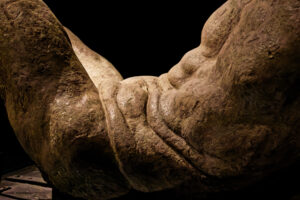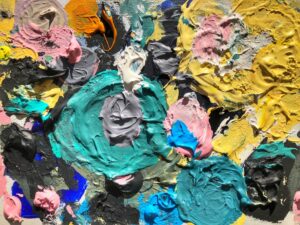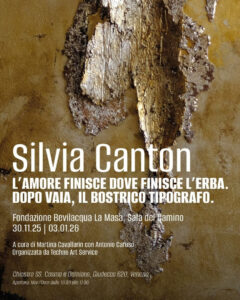The Invisible Villages project reaches an important stage with the conclusion of the first phase of work on Palazzo Lenci: restored façades and rediscovered halls amidst ancient decorations and precious views of the city. Today the building site can be visited, inaugurated on the occasion of the Tàvlata sul Castel. From 3 to 30 August, the exhibition ‘The Cities of Calvin’ in collaboration with the Academy of Fine Arts of the city of Palermo and the Elmad Institute of Paris. Michele Sbrissa, administrator of 593 Studio: “The open building site in Barchi is an example of shared design with a high social value”.
The restoration of Palazzo Lenci returns an important part of its historical and urban identity to the village of Barchi. The first phase of the building site launched by 593 Studio, a Veneto-based company specialising in participatory architecture, which implemented the project in collaboration with the Filippin-La Salle Institutes Italy, has been completed. The work restored splendour to the façades and defined the building’s exterior volumes, giving new life to the central square.
But it is during the work inside some of the palace’s rooms that the most exciting discoveries have been made: walled-in passageways, stairways and beams previously covered by cement, ephemeral traces of pictorial graphics and floral decorations resurfacing after centuries, confirming the initial intuitions and the suggestions of the stories told by citizens.
“We are bringing these elements back to light with patience and care, also through the workshops organised together with the Filippin Institutes, these traces of history were not documented, and we did not expect such a high quality, such elegance and beauty of craftsmanship,” explains Michele Sbrissa, founder and CEO of 593 Studio. “It is a sign that the palace is not just architecture, but a continuous narration, a discovery that opens up to the community. As planned, we will now suspend the operational activities of the building site and open these spaces to those who wish to have an extraordinary experience of history, architecture, art and participation. Palazzo Lenci is once again a living, visitable place, open to the community. With humility and thanks to the support of those who are believing in this adventure that is being written day by day, we can say that we are on the right track.”
Antonio Sebastianelli, mayor of Terre Roveresche, the municipality to which the village of Barchi belongs, emphasises: “The building site of Palazzo Lenci has allowed us to return to Barchi an important backdrop to the original project of the ideal city designed by architect Filippo Terzi. In just a few months, our square has returned to a dialogue with the stones and volumes of a building that had been silent for too long. We hope that this is only the beginning’.
On 3 August, in fact, on the occasion of the great popular festival La Tàvlata sul Castel, promoted by the Pro Loco di Barchi, which every year attracts over a thousand people, the exhibition “Le città di Calvino” (Calvino’s Cities) will be inaugurated, realised within the Invisible Villages project(www.borghinvisibili.it), in collaboration with the Academy of Fine Arts of Palermo, ELMAD Auguste Renoir of Paris, the Lasallian Institutes and the patronage of the municipalities of San Costanzo and Terre Roveresche.
The exhibition, which will remain open until 30 August, will be set up amidst the traces of the restoration work in progress, doors, fireplaces, floors, beams, corridors to be re-inhabited, offering the public a small experience, a taste of interaction between fragments of history and contemporary graphic visions inspired by Italo Calvino’s masterpiece, to which three works created by the Compagnia delle Catenelle di Barchi have been put side by side in an extraordinary way.
All this was also made possible thanks to the commitment of volunteers and local companies that participated by providing materials and solutions to set up the spaces in a functional and safe manner, in particular Z Impianti, which made the lighting design of the exhibition possible.
“The workshops that we organised in the building site of Palazzo Lenci allowed the students to experience not only material activities within these spaces, but what it means to interact and contribute to the activation of a community,” comments Sileno Rampado, general director of the Istituti Filippin. “This year we brought two groups of students here from Paderno del Grappa to participate in the social building site and the regeneration project. It is a school of life, combining hands, ideas, memory and future. Not only that, from next year six Lasallian high schools from all over Italy will use the spaces of Barchi for alternating school work, so the students will be able to participate in the permanent worksite of Palazzo Lenci, interweaving their experience with inhabitants, local economic activities, testimonies of artisans and associations, according to the generating idea of the Invisible Villages project.
The construction site will be open in this immersive mode for the entire month of August, with openings guaranteed by a number of local families and volunteers, further testifying to the extraordinary nature of the participatory process underway, hosted for many activities with the local community, in the spaces of the Nova Bar, one of the first businesses that believed in this idea.
Domenico Carbone, mayor of San Costanzo, the city that will host the exhibition now opening at Palazzo Lenci in the autumn, as part of the broader dissemination of the Invisible Villages project, adds: “This project, this construction site, is a virtuous example of regeneration for our villages: creativity and concreteness, networking and creating synergies from below, with our citizens and local businesses. It is a sign of the enormous possibilities of our territory, combining beauty and history with new dimensions of doing, oriented towards the future and internationality”.
From next autumn, the technicians will get back to work to start a new phase of planning and redevelopment of Palazzo Lenci, seeking, with patience and by treasuring the indications that are emerging from the community, to welcome and enhance the ideas gathered so far, in keeping with the objective of relaunching Barchi’s small Renaissance masterpiece, in the context of the broader programme of activities of Invisible Villages.
IN-DEPTH INFORMATION SHEETS
THE PURCHASE AND RESTORATION OF PALAZZO LENCI IN BARCHI
In the Renaissance village of Barchi, a hamlet of the municipality of Terre Roveresche (in the province of Pesaro Urbino), about six months ago the regeneration project of Palazzo Lenci, a symbolic building of the ‘ideal city’ conceived in the 16th century by architect Filippo Terzi on behalf of Marquis Pietro Bonarelli della Rovere, began. The palazzo, forgotten for decades, was purchased by the Treviso-based engineering and architecture company 593 Studio, specialised in participatory architectural design. The aim: to create a permanent building site capable of hosting reflections and actions in the fields of culture, housing, production and ethical and sustainable accommodation. In March this year, the first phase of the construction site was launched with an initial symbolic action: the reopening of Vicolo degli Ebrei, to mark the return of the building to the community. In parallel, ‘social regeneration’ is being worked on, involving local associations, cooperatives and students from the Istituto Filippin in Paderno del Grappa, Treviso. From a technical point of view, the first phase involved the facades, roof and historic chimneys, with a focus on recovering the architectural identity of the place. In addition, a new effigy will be created on the keystone of the stone portal at the entrance to the palace, which will unite history and the future, the ancient and the contemporary, a symbolically relevant element, on which the creative team is already thinking together with some local actors. Not only that. On the portal www.borghinvisibili.it it has been possible to explore for a few weeks now the entire territorial project that ranges from the sea of Torrette to the village of Barchi, passing through San Costanzo, Piagge, Orciano, and many other places, a project in full development, which will be enriched over time with the countless actions already undertaken and which will be illustrated here. Inside the site it is already possible to experience the three-dimensional navigation of the villages of Barchi and Cerasa reconstructed with laser scanner technology and photogrammetry through drones: an immersive digital journey among the medieval geometries of ancient villages.
THE EXHIBITION – CALVIN’S TOWNS
Curated as part of the Invisible Villages project, the exhibition was created as a visual homage to Calvin’s universe. The works, exhibited in the unfinished and restored rooms of Palazzo Lenci, interpret the famous book “The Invisible Cities” with graphic and illustrative languages. On display are approximately 40 original works including illustrations, graphic novels and installations, all created by young artists from the Academy of Fine Arts in Palermo and the ELMAD school in Paris. Among the authors are the works of teachers Renato Galasso, Emanuele Gizzi and Leandra La Rosa. Also exhibited were the students: Alessio Agosta, Federica Arrampatore, Marta Baglieri, Greta Calandrino, Noemi Carollo, Claudia Di Miceli, Chloé Desoubrie, Roberta Ferrigno, Riccardo Galantino, Emanuela Galioto, Claudia Galluzzo, Chloé Gillet, Antonino Graziano, Grabiel Kraft, Louisa Masselis, Roberto Palmeri, Roberto Rizzo, Andrea San Brunone, Saku Santeri Heinonen, Giorgio Vaccaro, Rebecca Verduci, Maria Francesca Villari. The installation blends with the unfinished space of the palace and the newly re-emerged historical decorations, in a continuous dialogue between past and vision. The route is made interactive thanks to installations by the ‘Compagnia delle Catenelle’, an artistic collective engaged in the creative regeneration of public spaces. The exhibition is part of a pedagogical and community project involving schools, local associations and regional institutions, and will be open from 3 to 30 August, Mondays, Fridays and Saturdays from 8 to 10 p.m. Information: 338 3517014
THE STORY OF 593STUDIO
593 STUDIO is an excellence in the panorama of engineering and architecture firms, committed to an ambitious mission: to build the future through research, experimentation and expertise. Founded in Castelfranco Veneto, in the province of Treviso, on solid values such as innovation, sustainability and collaboration, 593 STUDIO operates in the key sectors of living (residential), preserving (restoration), working (office) and sharing (public). With over 15 years of experience in Italy and abroad, 593 STUDIO’s multidisciplinary team tackles complex projects with dedication, from conception to operational management. Among the first Benefit Corporation in the professional services sector in Italy, the company is committed to giving back value to the community and the environment. Significant projects in the field of historical and sacred heritage conservation include the extension of the Santuari Antoniani complex in Padua, the restoration of the vaults of the San Francesco church in Treviso, the recovery plan for the former Monastero delle Clarisse in Castelfranco Veneto, the selection for the Cappella nel Bosco workshop-competition in La Verna, as well as consultancy services in various dioceses for community participation paths and property valorisation plans. 593 STUDIO also promotes innovation in the academic sphere and, in collaboration with the Lasallian Institutes and the IUAV, promotes and co-finances pioneering PhDs in the management and recovery of religious property. Research in technology and engineering is carried out in cooperation with the International University of Applied Science in Germany.



